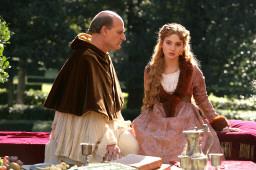A Renaissance portrait previously believed to be of a young man is in fact the world's only painting of the infamous Lucrezia Borgia, an Australian museum claimed on Tuesday.
The National Gallery of Victoria in Melbourne bought the work, formerly known as Portrait of a Young Man by an unidentified artist, in London in 1965.
Showing a stern-looking and rather androgynous sitter against a floral background, the painting has long had experts puzzled, with some suggesting that the background was a later addition and that the entire panel may have been cut from an original rectangular painting.
But gallery curator Carl Villis said years of study have revealed that both the background and the oval form are original, identifying the painting as a portrait of Borgia by one of Italy's foremost late Renaissance artists, Dosso Dossi (1486-1542).
Until recently, it was thought that oval paintings did not exist in Italy in the first half of the 16th century, but new research has shown that Dossi and his brother Battista worked with the form between 1515 and 1520 at the court of Ferrara, Villis said.
This coincides with the period in which Lucrezia Borgia ruled the city, when the Duke of Ferrara and her third husband, Alfonso d'Este, was called away to battle.
Clues that the sitter may be Borgia include the presence of a myrtle bush, which represents the goddess Venus and is a clear sign that the painting is of a woman, Villis said.
The presence of a dagger, which would usually be highly unusual in a portrait of a woman, in this case symbolises the legendary Roman noblewoman Lucretia, who killed herself with a dagger after being raped by the son of the king of Rome.
''Generations of art historians have tried to identify a painting of Lucrezia Borgia, but this seems to be the only one which contains personal references to this intriguing historical character,'' Villis said.
There are also striking facial similarities between the sitter and a 1502 bronze medal of Borgia, Villis added.
DEADLY REPUTATION MORE MYTH THAN REALITY.
Scholars today agree that Lucrezia Borgia's reputation as a deadly, golden-haired temptress, the embodiment of female evil and prolific poisoner is more myth than historic fact.
In the preface to his 1833 play, Lucrece Borgia, Victor Hugo wrote: ''Who, actually, is Lucrezia Borgia? Take the most hideous, the most repulsive, the most complete moral deformity, [and] place it where it fits best - in the heart of a woman whose physical beauty and royal grandeur will make the crime stand out all the more strikingly''.
Lucrezia was the illegitimate daughter of Pope Alexander VI, Rodrigo Borgia, and more than a temptress she was known in her lifetime as patron of the arts and a keen administrator.
In fact, her father took the unheard-of step of leaving the Vatican's administration in Lucrezia's hands at the tender age of 21.
Her skills really came to the fore, however, when she took control of Ferrara's administration for Alfonso d'Este.
Lucrezia ruled Ferrara with a firm, capable hand between 1509 and 1513, successfully bringing her adopted city through a period of intense turmoil, as it was ravaged by famine and plague.
Alfonso d'Este was her third and last husband and her bad reputation apparently stemmed from her second marriage, to Alfonso, Duke of Bisceglie, who was murdered.
Two years after their marriage, Alfonso survived an attack by henchmen only to be strangled in his bed while under Lucrezia's care.
While popular tradition says Lucrezia was behind the attack and murder, most historians point the finger at Cesare Borgia, Lucrezia's brother and the inspiration for Machiavelli's The Prince.
Lucrezia, born to Pope Alexander's mistress Vanozza Catanei, had been betrothed twice by the time she finally married Giovanni Sforza at the age of 13.
However, her father began seeking a more profitable alliance when the Sforzas fell from favor, and Giovanni fled, fearing for his life.
The marriage was annulled in 1497 by Alexander VI on the grounds of non-consummation, and Lucrezia, pregnant at the time from another liaison - popularly believed with her father or brother - was declared a virgin.
The following year she married the Duke of Bisceglie.
After his murder Lucrezia married Alfonso d'Este to whom she bore four children, dying in 1519 at the age of 39 due to complications in childbirth.
According to a courtier of the time, Niccolo Cagnolo, Lucrezia was: ''of middle height and graceful of form; her face is rather long, as is her nose; her hair is golden, her eyes gray, her mouth rather large, the teeth brilliantly white, her bosom smooth and white and admirably proportioned. Her whole being exudes good humor and gaiety''.






